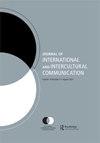中国男同性恋妻子如何进行共文化交流:文化、身份和意义建构
IF 1.4
Q2 COMMUNICATION
Journal of International and Intercultural Communication
Pub Date : 2020-01-02
DOI:10.1080/17513057.2019.1569252
引用次数: 6
摘要
中国约有1360万异性恋女性与同性恋或双性恋男性结婚,她们称自己为“同妻”。同妻既属于共同文化群体(作为女性和妻子),也属于主导群体(作为异性恋者)。本研究通过对同妻所讲的51个故事的叙事分析,探讨了同妻使用的共文化策略,并确定了两种新的共文化策略:自责和忍耐。研究还考察了同妻如何以叙事方式构建丈夫的共文化策略,并发现同妻在其意义建构过程和与丈夫的交流反应中往往内化了意识形态(性别、性取向、婚姻和家庭)。本文章由计算机程序翻译,如有差异,请以英文原文为准。
How gay men’s wives in China practice co-cultural communication: Culture, identity, and sensemaking
ABSTRACT Around 13.6 million heterosexual women in China are married to gay or bisexual men, and they call themselves tongqi. Tongqi belong to both co-cultural groups (as women and wives) and a dominant group (as heterosexuals). Through a narrative analysis of 51 stories told by tongqi, this study examines the co-cultural strategies tongqi use, and identifies two novel co-cultural strategies: self-blaming and enduring. It also examines how tongqi narratively construct their husbands’ co-cultural strategies and finds that tongqi often internalize the ideologies (of gender, sexual orientation, marriage, and family) in their sensemaking process and in their communicative responses to their husbands.
求助全文
通过发布文献求助,成功后即可免费获取论文全文。
去求助
来源期刊

Journal of International and Intercultural Communication
COMMUNICATION-
CiteScore
3.80
自引率
12.50%
发文量
19
 求助内容:
求助内容: 应助结果提醒方式:
应助结果提醒方式:


